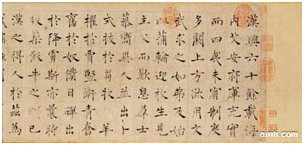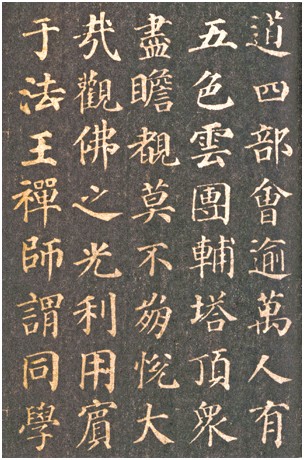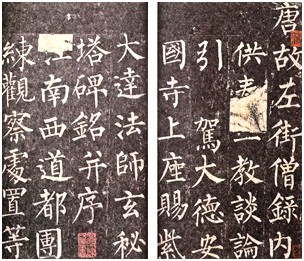Navigation article:
Origin and Growth and development of Groups of Calligraphy and Appreciation and Analysis of Calligraphy
Regular Script
Regular script is also referred to as “uniform script” and “real script”, talking about a typeface of order. Regular script is really a regular typeface directly started out clerical script. It switched the “silkworm mind and wild goose tail” of clerical script right into a flat and straight form. The term turns from being flat to square and regular. Regular script started to bud within the late Han empire, gaining momentum in Wei-Jin South and north dynasties and reaching its prime within the Tang empire. This script has continued to be being used so far and it is the essential skill people must learn well within their study of calligraphy.
*Selected Works

Chu Suiliang(595-658)together with Ouyang Xun(557-641), Yu Shinan (558-638)and Xu Ji(649-713)are referred to as four major masters in early Tang empire. When the introduction of regular script had arrived at happens from the four major masters, the horizontal line appearing flat and also the vertical line appearing straight finally was achieved. Also, rules and also the format signing up to each us dot and every line were also set. Therefore, lots of people think that authentic regular script didn’t mature before the Tang empire. Chu’s work uses slender and energetic brushes. Rooms can be found in the composition of figures. The strokes are versatile thick. Refinements within the movements of stop and tick increase the attraction of Chu’s calligraphy.

Yan Zhenqing(709-789)turned the elongated composition of standard script in early Tang empire right into a square-form. However in the where you started can easily see a circle. And every character offers a centripetal pressure. In the utilisation of the brush, Yan started his stroke using the mind appearing subtle and handle it with twists. His line is bulging. Design is of density and lushness, echoing using the golden chronilogical age of the Tang empire. A Brief History of calligraphy claims that Yan’s figures could demonstrate his righteousness and upright character.
Duobao Pagoda Stele may be the early work of Yan. The work consists so as and solemnity with cursive and effective strokes. Individuals following Yan should first of all learn Duobao Pagoda Stele before learning Yan’s other works. In this manner, it might be simpler to understand the figures of Yan’s calligraphy.

The Status of Liu Gongquan’s (778-865) regular script is on componen with Yan Zhenqing’s. But Liu’s strokes are less portly than Yan’s because they are slender and rigid with sharp angles, being orderly configured. Liu stated that “a heart of righteousness” is really a prerequisite permanently calligraphy and Yan is definitely an example. This kind of idea implies that the morality from the calligraphers is definitely an influential aspect in Chinese calligraphic critique.
Liu’s utilization of brush and also the characters’ composition embody the credentials from the masters of Ouyang Xun, Yu Shinan, Chu Suiliang and Yan Zhenqing, as though offering one conclusion towards the order of standard script from the Tang empire while creating its very own unique style and college.
The Mysterious Pagoda Stele demonstrates the peculiarity of Liu’s works and the strength of control worked out over his figures. The strokes are sharp, starting with a pressing pressure, carried out in a square-formed ending. Turning points mostly appear angular. Intensity runs with the whole text without having to be pressing. The Mysterious Pagoda Stele offers the characteristics of strength and magnificence of Liu, to be the model for Liu’s works.
Source: www.cityu.edu.hk